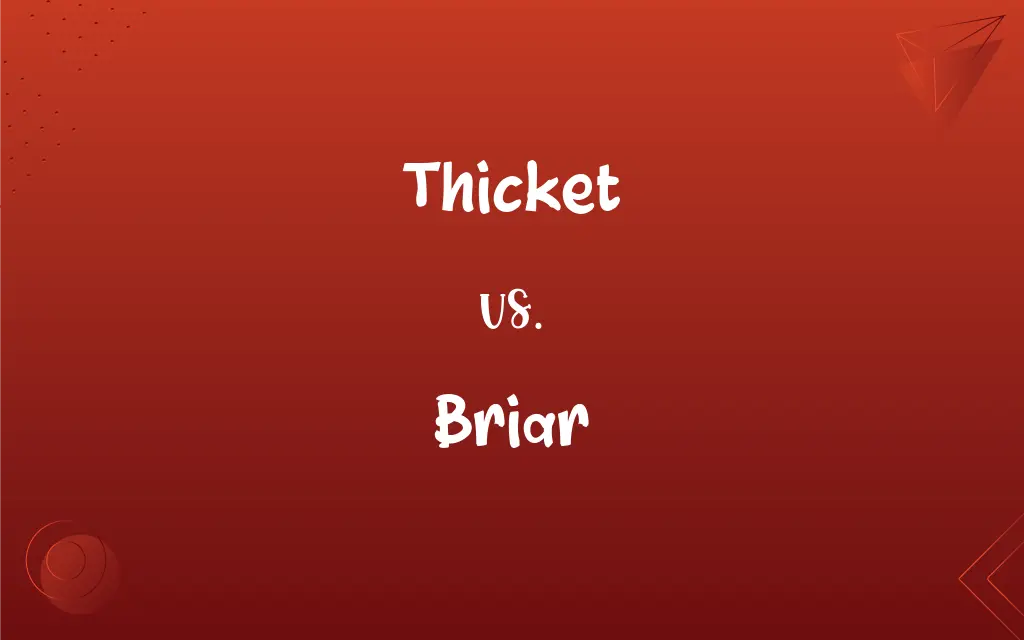Thicket vs. Briar: What's the Difference?
By Harlon Moss & Aimie Carlson || Updated on May 29, 2024
A thicket is a dense group of shrubs or small trees, often difficult to navigate, while a briar is a type of thorny plant or bush.

Key Differences
A thicket refers to a dense collection of shrubs, bushes, or small trees growing closely together. Thickets can be found in various environments, providing shelter for wildlife and often presenting challenges for navigation due to their density. On the other hand, a briar specifically denotes a thorny plant or bush, such as wild roses or brambles. Briars are characterized by their prickly stems, which can cause physical discomfort or injury if touched. They often grow within or at the edges of thickets but are defined by their thorniness rather than their density.
While thickets emphasize the closeness and density of vegetation, making them thick and impenetrable, briars highlight the presence of thorns, focusing on the potential for harm or difficulty in handling.
Thickets can include a variety of plant species, both thorny and non-thorny, whereas briars are specifically those plants with thorny stems. Thickets contribute to the structure and biodiversity of an ecosystem, while briars often serve as natural barriers due to their thorns.
In terms of usage, thickets are more commonly referred to in general descriptions of dense vegetation, whereas briars are mentioned specifically when the thorny nature of the plants is relevant.
Comparison Chart
Definition
A dense group of shrubs or small trees
A thorny plant or bush, like a wild rose or bramble
ADVERTISEMENT
Focus
Density and closeness of vegetation
Presence of thorns
Navigation
Often difficult to navigate
Can cause physical discomfort or injury due to thorns
Plant Species
Various species, both thorny and non-thorny
Specifically thorny plants
Ecological Role
Shelter for wildlife, contributes to biodiversity
Natural barriers, protection with thorns
Usage Context
General descriptions of dense vegetation
Specific mention of thorny nature
ADVERTISEMENT
Thicket and Briar Definitions
Thicket
A dense group of shrubs, bushes, or small trees growing closely together.
The hikers struggled to make their way through the dense thicket.
Briar
Plants known for their thorny stems.
The briar's sharp thorns made it difficult to harvest the berries.
Thicket
An area of dense, tangled vegetation.
The rabbit darted into a thicket to escape the fox.
Briar
A thorny plant or bush, such as a wild rose or bramble.
She carefully avoided the briar to prevent getting scratched.
Thicket
A thick, impenetrable growth of plants.
The path was blocked by an overgrown thicket.
Briar
Any prickly, scrambling shrub, typically found in the wild.
The path was overgrown with briars and brambles.
Thicket
A section of a forest with closely packed undergrowth.
The thicket provided a perfect hiding place for the deer.
Briar
A thorny shrub that can create natural barriers.
The briar hedge served as a deterrent to animals and intruders.
Thicket
Dense vegetation that creates a natural barrier.
The thicket of bushes formed a natural fence around the garden.
Briar
A type of plant with sharp, hooked thorns.
The old fence was covered in briars, making it hard to climb.
Thicket
A dense growth of shrubs or underbrush; a copse.
Briar
Any of several prickly plants, such as certain rosebushes or the greenbrier.
Thicket
Something suggestive of a dense growth of plants, as in impenetrability or thickness
"the thicket of unreality which stands between us and the facts of life" (Daniel J. Boorstin).
Briar
A Mediterranean shrub or small tree (Erica arborea) in the heath family, whose woody roots are used to make tobacco pipes. Also called tree heath.
Thicket
A dense, but generally small, growth of shrubs, bushes or small trees; a copse.
Briar
A pipe made from the root of this plant or from a similar wood.
Thicket
(figuratively) A dense aggregation of other things, concrete or abstract.
He had to complete a thicket of paperwork before he was allowed to join the company.
Briar
Variant of brier1.
Thicket
The collection of many small linked files created when a document is saved in HTML format by some word processors and web site creation software.
Briar
Any of many plants with thorny stems growing in dense clusters, such as many in the Rosa, Rubus, and Smilax genera.
Thicket
A wood or a collection of trees, shrubs, etc., closely set; as, a ram caught in a thicket.
Briar
(figurative) Anything sharp or unpleasant to the feelings.
Thicket
A dense growth of bushes
Briar
The white heath (Erica arborea), a thorny Mediterranean shrub.
Briar
A pipe for smoking, made from the roots of that shrub.
Briar
Same as Brier.
Briar
Eurasian rose with prickly stems and fragrant leaves and bright pink flowers followed by scarlet hips
Briar
A very prickly woody vine of the eastern United States growing in tangled masses having tough round stems with shiny leathery leaves and small greenish flowers followed by clusters of inedible shiny black berries
Briar
Evergreen treelike Mediterranean shrub having fragrant white flowers in large terminal panicles and hard woody roots used to make tobacco pipes
Briar
A pipe made from the root (briarroot) of the tree heath
FAQs
Why are thickets important for wildlife?
Thickets provide shelter, food, and protection for various wildlife species.
What is a thicket?
A thicket is a dense group of shrubs or small trees growing closely together.
What is a briar?
A briar is a type of thorny plant or bush, such as a wild rose or bramble.
Are all plants in a thicket thorny?
No, thickets can contain a variety of plant species, both thorny and non-thorny.
Can briars grow in thickets?
Yes, briars can grow within or at the edges of thickets.
How do thickets contribute to biodiversity?
Thickets create diverse habitats that support various plant and animal species.
Can briars be deliberately planted?
Yes, briars can be planted for ornamental purposes or to create natural barriers.
Do briars have any ecological benefits?
Yes, briars provide habitat and protection for certain animals and help prevent soil erosion.
Do thickets require specific environmental conditions?
Thickets can thrive in various environments, from forests to grasslands.
Are briars beneficial to any particular wildlife?
Yes, certain birds and animals rely on briars for nesting sites and food sources.
Can thickets be found in urban areas?
Yes, thickets can develop in urban areas, especially in parks and green spaces.
Can thickets hinder human activities?
Yes, dense thickets can impede movement and make land difficult to traverse or develop.
What makes briars difficult to handle?
Briars are difficult to handle due to their thorny stems, which can cause scratches and injuries.
Can a thicket become a natural barrier?
Yes, the density of a thicket can create a natural barrier that is difficult to penetrate.
Are briars used for any practical purposes?
Briars can be used to create natural fences or barriers and their fruits can be harvested.
What happens if a thicket becomes overgrown?
An overgrown thicket can become even more impenetrable and potentially spread to unwanted areas.
How do briars protect themselves?
Briars protect themselves with sharp thorns that deter herbivores and humans.
What types of animals live in thickets?
Various animals, including birds, small mammals, and insects, use thickets for shelter and food.
How can briars be controlled or managed?
Briars can be managed through regular pruning, controlled burns, or herbicide applications.
Are briars only found in the wild?
No, briars can be found in both wild and cultivated settings.
About Author
Written by
Harlon MossHarlon is a seasoned quality moderator and accomplished content writer for Difference Wiki. An alumnus of the prestigious University of California, he earned his degree in Computer Science. Leveraging his academic background, Harlon brings a meticulous and informed perspective to his work, ensuring content accuracy and excellence.
Co-written by
Aimie CarlsonAimie Carlson, holding a master's degree in English literature, is a fervent English language enthusiast. She lends her writing talents to Difference Wiki, a prominent website that specializes in comparisons, offering readers insightful analyses that both captivate and inform.
































































